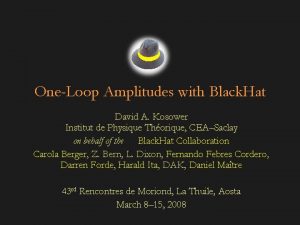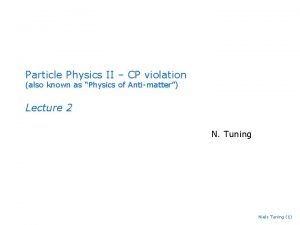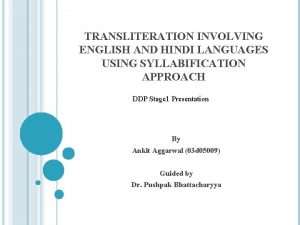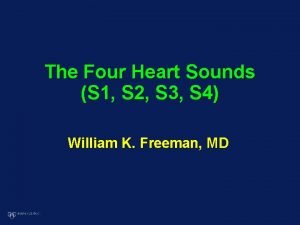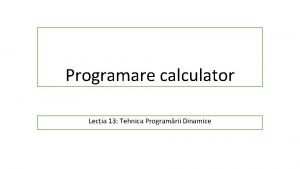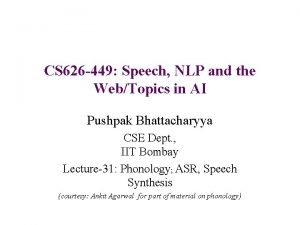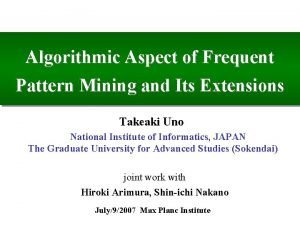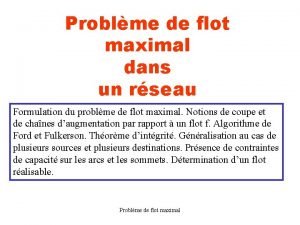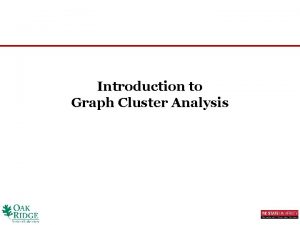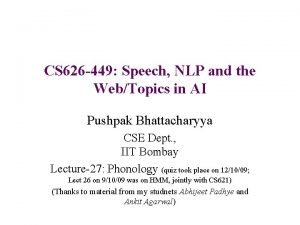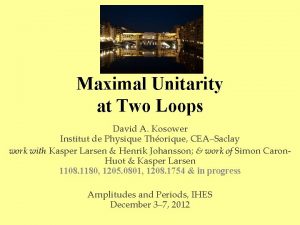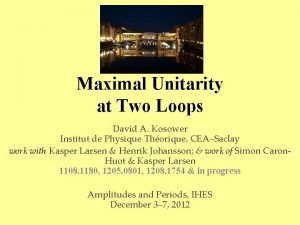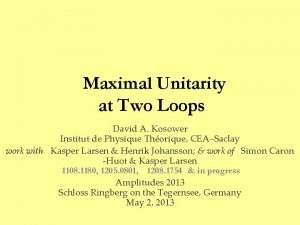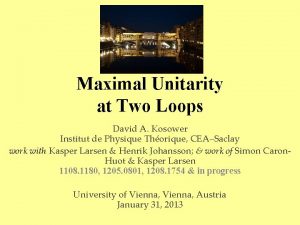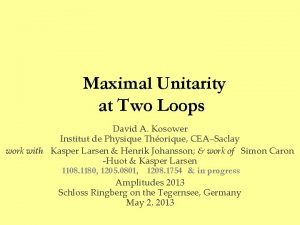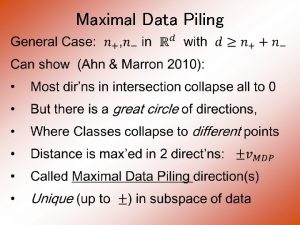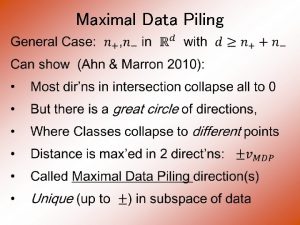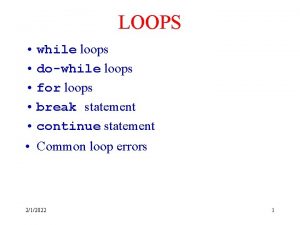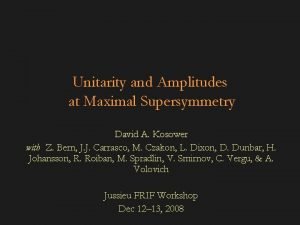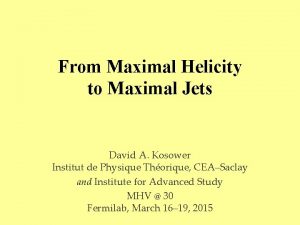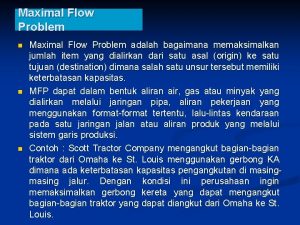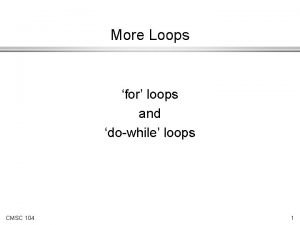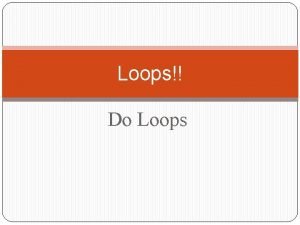Maximal Unitarity at Two Loops David A Kosower














- Slides: 14

Maximal Unitarity at Two Loops David A. Kosower Institut de Physique Théorique, CEA–Saclay work with Kasper Larsen & Henrik Johansson; & work of Simon Caron -Huot & Kasper Larsen 1108. 1180, 1205. 0801 & in progress ICHEP 2012, Melbourne July 5, 2012

Amplitudes in Gauge Theories • Basic building block for physics predictions in QCD • NLO calculations give the first quantitative predictions for LHC physics, and are essential to controlling backgrounds: require one-loop amplitudes many talks • For some processes (gg W +W −, gg ZZ) two-loop amplitudes are needed • For NNLO & precision physics, we also need to go beyond one loop

So What’s Wrong with Feynman Diagrams? • Huge number of diagrams in calculations of interest — factorial growth • 2 → 6 jets: 34300 tree diagrams, ~ 2. 5 ∙ 107 terms ~2. 9 ∙ 106 1 -loop diagrams, ~ 1. 9 ∙ 1010 terms • But answers often turn out to be very simple • Simple results should have a simple derivation — Feynman (attr) • Want approach in terms of physical states only: remove contributions of gauge-variant off-shell from the start

On-Shell Methods • Use only information from physical states • Use properties of amplitudes as calculational tools – Factorization → on-shell recursion (Britto, Cachazo, Feng, Witten, …) – Unitarity → unitarity method (Bern, Dixon, Dunbar, DAK, …) – Underlying field theory → integral basis • Formalism Unitarity • For analytics, independent integral basis is nice; for numerics, essential

Unitarity-Based Calculations Bern, Dixon, Dunbar, & DAK, ph/9403226, ph/9409265 Replace two propagators by on-shell delta functions Sum of integrals with coefficients; separate them by algebra Generalized Unitarity: pick out contributions with more than two specified propagators Maximal Generalized Unitarity: cut all four components of loop momentum to isolate a single box Britto, Cachazo & Feng (2004)

Quadruple Cuts Work in D=4 for the algebra Four degrees of freedom & four delta functions … but are there any solutions? Yes, but they are complex: e. g. k 12 = 0 = k 42

• Solutions are complex • The delta functions would actually give zero! Need to reinterpret delta functions as contour integrals around a global pole • Reinterpret cutting as contour replacement

Two Problems • We don’t know how to choose the contour • Deforming the contour can break equations: is no longer true if we deform the real contour to circle one of the poles Remarkably, these two problems cancel each other out: requiring the vanishing forces a 1 = a 2 in a general contour

Massless Planar Double Box [Generalization of OPP: Ossola & Mastrolia (2011); Badger, Frellesvig, & Zhang (2012)] • Here, generalize work of Britto, Cachazo & Feng, and Forde • Take a heptacut — freeze seven of eight degrees of freedom • One remaining integration variable z • Six solutions, for example

• Need to choose contour for z within each solution • Jacobian from other degrees of freedom has poles in z: 8 distinct solutions aka global poles once one removes duplicates • Note that the Jacobian from contour integration is 1/J, not 1/|J|

Picking Contours • We can deform the integration contour to any linear combination of the 8; which one should we pick? • Need to enforce vanishing of all total derivatives: – 5 insertions of ε tensors 4 independent constraints – 20 insertions of IBP equations 2 additional independent constraints • Seek two independent “projectors”, giving formulæ for the coefficients of each master integral – In each projector, require that other basis integral vanish – Work to O (ε 0); higher order terms in general require going beyond four-dimensional cuts

• Contours • Up to an irrelevant overall normalization, the projectors are unique, just as at one loop • More explicitly,

Massive Double Boxes Massive legs: 1; 1 & 3; 1 &4 Master Integrals: 2 Global Poles: 8 Constraints: 2 (IBP) + 4 (ε tensors) = 6 Unique projectors: 2 Massive legs: 1 & 3; 1, 2 &3 Master Integrals: 3 Global Poles: 8 Constraints: 1 (IBP) + 4 (ε tensors) = 5 Unique projectors: 3 Massive legs: all Master Integrals: 4 Global Poles: 8 Constraints: 0 (IBP) + 4 (ε tensors) = 4 Unique projectors: 4

Summary • First steps towards a numerical unitarity formalism at two loops • Criterion for constructing explicit formulæ for coefficients of basis integrals • Four-point examples: massless, one-mass, two-mass double boxes
 David kosower
David kosower Unitarity triangle
Unitarity triangle Hindi syllable structure
Hindi syllable structure Auscultate heart sounds
Auscultate heart sounds Maximal 2 radna bilježnica
Maximal 2 radna bilježnica Point of maximal impulse
Point of maximal impulse Fundamental teaching techniques of lsvt big
Fundamental teaching techniques of lsvt big Problema triunghiului programare dinamica
Problema triunghiului programare dinamica Zscore
Zscore Phonteic alphabet
Phonteic alphabet Reverse image search
Reverse image search Flot maximal
Flot maximal Maximal clique
Maximal clique Maximal onset principle example
Maximal onset principle example Maximal heart rate
Maximal heart rate
